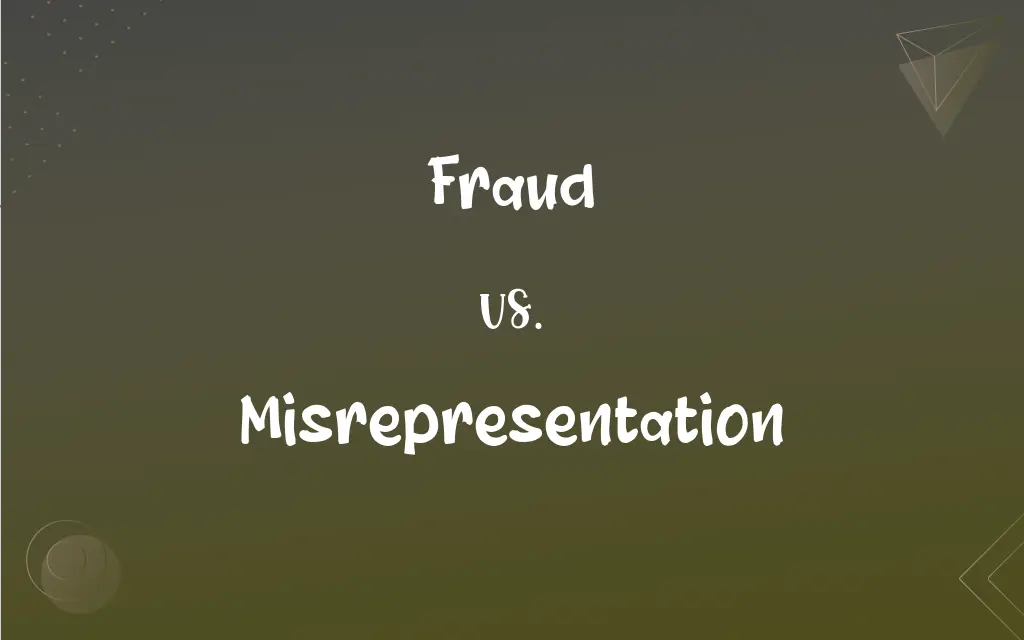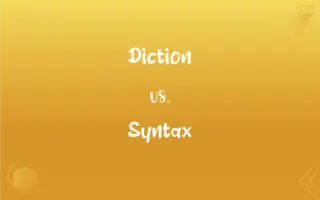Fraud vs. Misrepresentation: What's the Difference?
Edited by Janet White || By Harlon Moss || Updated on October 20, 2023
Fraud involves intentional deception for gain, while misrepresentation is the false statement of a fact, whether intentional or not.

Key Differences
Fraud is a deliberate act of deception made for personal gain or to damage another individual. Misrepresentation, on the other hand, refers to a statement that is not true, but it doesn't always imply a deliberate intent to deceive.
In legal contexts, fraud usually requires an intent to deceive and is often associated with criminal intent. Misrepresentation might not always have malicious intent; someone might provide false information unknowingly.
Fraud can lead to criminal penalties because it involves deliberate deception to gain something of value or harm someone else. Misrepresentation, in many cases, is a civil matter, which means the person who made the false statement might be required to compensate the aggrieved party, but won't necessarily face criminal charges.
The key distinction is intentionality. Fraud is always intentional. Misrepresentation can be either intentional (fraudulent misrepresentation) or unintentional (innocent or negligent misrepresentation).
Comparison Chart
Definition
Intentional deception for personal gain or harm to others.
False statement of fact, whether intentional or not.
ADVERTISEMENT
Intent
Always intentional.
Can be intentional or unintentional.
Consequences
Can lead to criminal penalties.
Primarily leads to civil consequences.
Common Legal Context
Criminal law.
Contract law.
Associated Terms
Scam, con, deceit.
False claim, misleading statement.
Fraud and Misrepresentation Definitions
Fraud
A misrepresentation made knowingly to cause loss to another.
The pyramid scheme was a fraud that cost investors millions.
ADVERTISEMENT
Misrepresentation
A statement that is not true or consistent with the facts.
The brochure contained a misrepresentation of the hotel's amenities.
Fraud
A deliberate deception to secure an unfair or unlawful gain.
The CEO was convicted of fraud after manipulating company finances.
Misrepresentation
An incorrect portrayal or description of something.
Her resume had a misrepresentation about her years of experience.
Fraud
Intentional distortion of facts to deceive someone.
The scam involved a major fraud scheme targeting elderly individuals.
Misrepresentation
A false statement made without the knowledge that it's false.
The salesman's claim was a misrepresentation as he genuinely believed the product had those features.
Fraud
A deceitful act with the aim to trick someone.
He committed fraud by forging the signature on the check.
Misrepresentation
A statement that presents facts in a way that is misleading.
The advertisement's misrepresentation led customers to expect more than what was offered.
Fraud
Act of cheating or deceiving to gain something.
Selling fake jewelry as genuine is a clear act of fraud.
Misrepresentation
Providing inaccurate or false information, intentionally or not.
The agent made a misrepresentation about the house's age.
Fraud
A deception practiced in order to induce another to give up possession of property or surrender a right.
Misrepresentation
To give an incorrect or misleading representation of.
FAQs
Is every misrepresentation considered fraud?
No, misrepresentation can be either intentional (fraudulent) or unintentional (innocent or negligent).
What does misrepresentation mean?
Misrepresentation is a false statement of fact, whether made intentionally or not.
Can fraud result in jail time?
Yes, fraud can lead to criminal penalties, including jail time.
Are all acts of fraud illegal?
Yes, fraud is illegal as it involves intentional deception for gain or harm.
Is fraud always a deliberate act?
Yes, fraud is always intentional and deliberate.
What is fraud?
Fraud is intentional deception for personal gain or harm to others.
Can misrepresentation be made unknowingly?
Yes, misrepresentation can be made without knowledge of its falsehood.
What's a common type of fraud in finance?
A common type is securities fraud, involving deceptive practices in the stock or commodities markets.
Is identity theft a form of fraud?
Yes, identity theft is a type of fraud where one's personal information is used without permission.
Can a mistake be considered misrepresentation?
Yes, if a statement is factually incorrect, even if unintentionally so, it can be a misrepresentation.
What's the key difference between fraud and misrepresentation?
The key difference is intent; fraud is always intentional, while misrepresentation can be either intentional or unintentional.
Can businesses be victims of fraud?
Yes, businesses can be victims, such as in cases of embezzlement or corporate fraud.
What legal actions can be taken against fraud?
Legal actions can include criminal charges, civil lawsuits, fines, and restitution.
Can an honest mistake in a contract be considered misrepresentation?
Yes, even an honest mistake can be grounds for voiding a contract if it's a material misrepresentation.
Are scams and cons synonymous with fraud?
Yes, scams and cons are forms of fraud involving deception.
Can misrepresentation be a ground for contract termination?
Yes, if a party entered a contract based on misrepresentation, they may have grounds to terminate or void it.
Can you sue someone for misrepresentation?
Yes, individuals can sue for damages resulting from misrepresentation.
Are verbal statements considered misrepresentation?
Yes, both verbal and written false statements can be considered misrepresentation.
Is exaggerating product features a form of misrepresentation?
Yes, exaggerating or overstating features can be considered misrepresentation.
Is phishing a type of fraud?
Yes, phishing is a type of fraud where attackers masquerade as trustworthy entities to collect sensitive information.
About Author
Written by
Harlon MossHarlon is a seasoned quality moderator and accomplished content writer for Difference Wiki. An alumnus of the prestigious University of California, he earned his degree in Computer Science. Leveraging his academic background, Harlon brings a meticulous and informed perspective to his work, ensuring content accuracy and excellence.
Edited by
Janet WhiteJanet White has been an esteemed writer and blogger for Difference Wiki. Holding a Master's degree in Science and Medical Journalism from the prestigious Boston University, she has consistently demonstrated her expertise and passion for her field. When she's not immersed in her work, Janet relishes her time exercising, delving into a good book, and cherishing moments with friends and family.































































